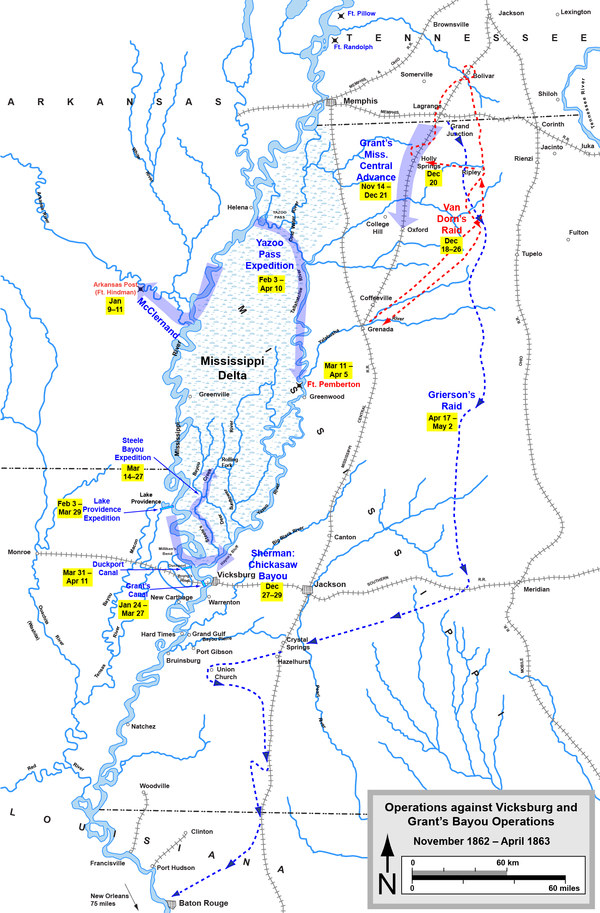150 years ago the United States Congress passed the National Banking
Act. It established a system of chartered national banks and required
the currency that the banks issued to be backed by government
securities. The act was to create a national paper currency that the
government printed and controlled, rather than many different state
or private banks printing the bank notes. It established the
Comptroller of the Currency, who inspected the national banks and was
responsible for the printing of bank notes. These new bank notes
would help finance the Civil War, because the banks had to buy
Treasury securities to issue the national bank notes. This banking
system was the foundation of the modern Federal Reserve.
Monday, February 25, 2013
Friday, February 22, 2013
Replica of the CSS Neuse
Labels:
Confederate Navy,
ironclad,
navy,
North Carolina,
video
Thursday, February 14, 2013
Queen of the West Captured
 |
| Fort DeRussy |
After running past
the Vicksburg batteries, the Union steamer Queen of the West
continued down the Mississippi
River, destroying the civilian boats along the shore. Charles Ellet,
her commander, proceeded as ordered up the Red River. Hearing of
three boats lying thirty miles up river at a place called Gordon's
Landing, Ellet set out to try capture them. He reached the place at
dusk on February 14, 150 years ago today. The steamer pulled forward
slowly, and encountered the
rebel Fort
DeRussy, a battery of four
guns in a fine position.
After several shots, Ellet ordered the pilot to pull the ship
back up the channel, but either accidentally or through malice, he
instead ran the ship aground.
 |
| Queen of the West abandoned |
Quickly getting
the range, the battery opened up with a hot fire. Nearly every shot
crashed through the ship. She took heavy damage, and filled with
steam when a pipe was severed by a shell. Knowing that it was of no
use to remain on the ship, pounded as she was by Confederate guns,
Ellet gave the order to abandon ship. She was not burnt because of
the wounded inside which could not be removed. The
Confederates secured and repaired her, and put her in action as the
CSS Queen of the West.
Labels:
battle,
ironclad,
Mississippi,
navy
Sunday, February 3, 2013
Yazoo River Canal
The next Union attempt to capture the town was an expedition down the Yazoo Pass. It was believed that by cutting a levy the Union might be able to find a passage through the Yazoo Pass and along the Tallahatchie River to bypass Vicksburg. On February 3rd, a levee was breached sending Mississippi River water down a channel, thus raising the Yazoo River. One Union officer wrote:
By 11 p.m. the opening was 40 yards wide, and the water pouring through like nothing else I ever saw except Niagara Falls. Logs, trees, and great masses of earth were torn away with the greatest ease. The work is a perfect success.An expedition set off down the river, but it was slow, hard going. Trees had to be felled to get the gunboats through, and obstacles placed by the Confederates had to be cleared. It would take weeks of hard work to discover if this narrow channel would prove the key to the Vicksburg Campaign.
Labels:
campaign,
Mississippi,
Mississippi River,
river,
Ulysses S. Grant,
Vicksburg
Saturday, February 2, 2013
Queen of the West Runs Vicksburg
_watercolor.jpg) |
| Queen of the West |
As the Queen of the West rounded the bend which led up to Vicksburg, the Confederates sprang to their guns and opened a heavy fire upon the Yankee ship. This fire, although terrific, was inaccurate, and the ship was struck only three times. The City of Vicksburg had been positioned so that a ram would have to swing out into the current to have a chance at a firm blow. That is just what Colonel Charles Ellet, captain of the Queen of the West did. But as the ship swung around, the current caught her and she lost all her momentum, as the Confederates planned. But Captain Ellet was ready for this. He wrote in his report:
I had anticipated this result, and therefore caused the starboard bow gun to be shotted with three of the incendiary projectiles recommended in your orders. As we swung around, Sergt. J. H. Campbell, detailed for the purpose, fired this gun. A 64-pounder shell crashed through the barricade just before he reached the spot, but he didn't hesitate. The discharge took place at exactly the right moment, and set the rebel steamer in flames, which they subsequently succeeded in extinguishing. At this moment one of the enemy's shells set the cotton on fire near the starboard wheel, while the discharge of our own gun ignited that portion which was on the bow. "The flames spread rapidly, and the dense smoke, rolling into the engine room suffocated the engineers. I saw that if I attempted to run into the City of Vicksburg again, my boat would certainly be burned. I ordered her to be headed down stream, and turned every man to extinguishing the flames. After much exertion, we finally put out the fire by cutting the burning bales loose. The enemy, of course, were not idle. We were struck twelve times, but, though the cabin was knocked to pieces, no material injury to the boat or to any of those on her was inflicted. About two regiments of rebel sharpshooters in rifle-pits kept up a continuous fire, but did no damage. The Queen was struck twice in the hull, but above the water line. One of our guns dismounted and ruined.
I can only speak in the highest terms of the conduct of every man on board. All behaved with cool, determined courage.
Labels:
battle,
bombardment,
ironclad,
Mississippi,
Mississippi River,
navy,
Vicksburg




